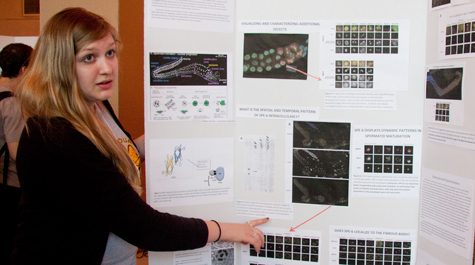Our undergraduate scientists show their stuff
William & Mary students are pushing the envelope when it comes to undergraduate research. Hundreds of them put their research on display when the College hosted the 18th Annual Undergraduate Science Research Symposium.
The symposium, which was held Feb. 24, is sponsored each year by the College’s Roy R. Charles Center and allows students who have conducted research in one of the sciences the opportunity to present their work. This year’s symposium included topics ranging from marine science and biology to mathematics and neuroscience.
Joel Schwartz, director of the Charles Center, said William & Mary provides students funding for research and creates opportunities for undergraduates to work with faculty in labs. The College provides these opportunities and conducts events such as the symposium in order to promote undergraduate research. Schwartz says that the presentation process is just as important as the research itself.
“The research publication and presentation is part of the research process because you throw your research out there for people to judge and ask questions. That’s how science progresses,” said Schwartz.
Dennis Manos, vice provost for research at the College, says the symposium allows students to share their excitement and enthusiasm for their research.
“You push your own boundaries. We can’t do that in a class. We can tell you about it in the classroom. When you go do it yourself, there’s no comparison,” Manos said.
Manos also says that undergraduate research is fundamental to the purpose of any university.
“Part of what we run this university for is to pass on the experience of former generations to the current generations so that you can continue to evolve that process,” he said.
More than 100 projects from 10 programs were presented at the symposium through both oral presentations and poster displays. Topics ranged from quantum chromodynamics to the effect of video games on spatial skills to the experience of awe.
Leah Towarnicky ’12 presented her research, “SPE-6: A Kinase that Promotes Multiple Key Transitions During C. elegans Spermatogenesis,” which applies to the understanding of fertility. Towarnicky says conducting research at the undergrad level has exposed her to new ways of thinking.
“This is a completely different way of thinking. I think that kind of Socratic way of asking why certain things happen, what do we not know, and what can we know better is important in medicine, but it’s also important in life,” Towarnicky said. “Really honing in those skills and developing a new way of thinking is what this research does.”
Brian Rabe ’13 presented his research, “Cloning and Functional Characterization of GABAA alpha and GABAB subunits in Xenopus During Development.” His work has numerous applications to stem cell therapy. Rabe said research provided him with a hands-on way to get an idea of what science is like in the real world.
“You learn that you don’t just go into the lab for a couple of hours and do an experiment and you’re done. It’s an ongoing process,” Rabe said.
Both students agree that their undergraduate research experience has opened doors for their career plans. Towarnicky plans on going to medical school and becoming an OBGYN, while Rabe has years of graduate research in his plans.
“I plan on pursuing a Ph.D. in developmental biology, and this has really done nothing but cement that goal in my mind. I wish more high school seniors applying knew we had these opportunities,” said Rabe.
Undergraduates at the symposium also said the symposium is one of a kind, in that many larger schools don’t offer the same opportunities as William & Mary does to conduct research so early in college.
“One reason I came to William & Mary is because of the research opportunities at a young age. A lot of other schools don’t let you do what we’re doing until you’re a junior or senior, so I am being exposed to a lot of things that only higher level students get at other schools,” said symposium participant Tyler Tancredi ’14.
Schwartz believes the research process is an important component of what a liberal education has always been about. Both Manos and Schwartz agree that undergraduate research at the College is critical to the William & Mary experience.
“At that moment, you’re not an English major, you’re not a historian, you’re not a physicist, you’re not a mathematician—you’re a problem solver. “ said Manos.



















